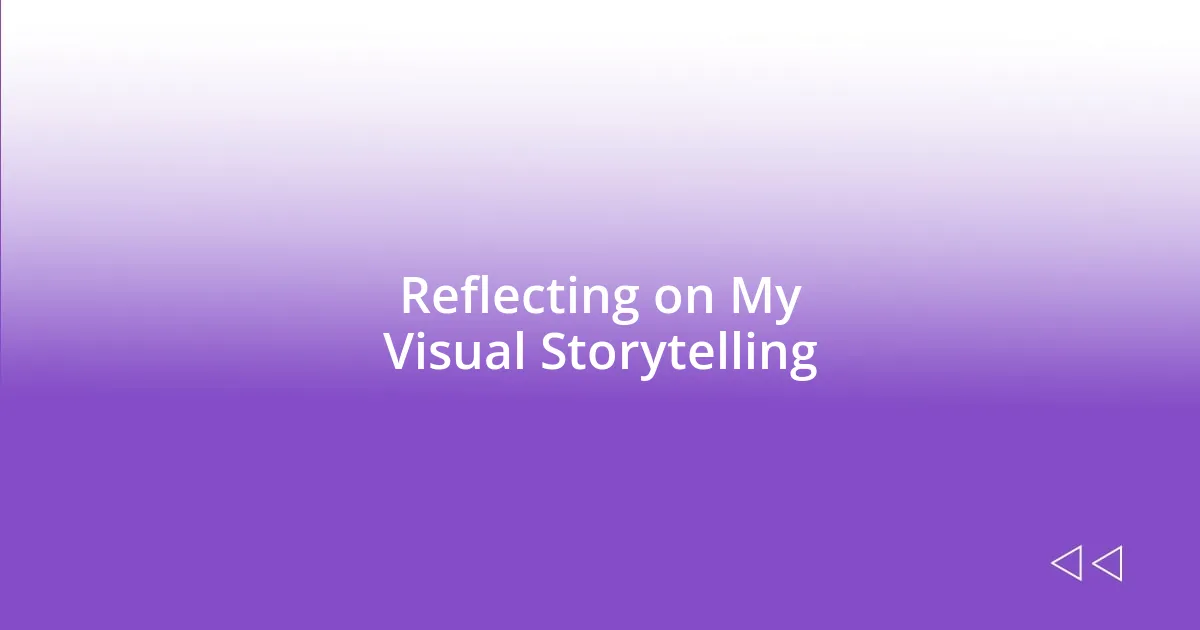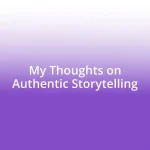Key takeaways:
- Visual storytelling transcends language, evoking emotions and narratives through imagery without words.
- Key elements of effective storytelling include character development, emotion, and pacing, enhancing audience engagement.
- Nature and personal encounters are significant sources of inspiration, providing profound narratives and shared human experiences.
- Building emotional connections often involves authentic representation and vulnerability, revealing deeper layers of human experience.

Understanding Visual Storytelling
Visual storytelling is a powerful tool that transcends language barriers, allowing emotions and concepts to be conveyed through imagery. I remember the first time I stood enthralled by a striking photograph; it felt like the image spoke directly to my heart. Have you ever experienced a moment like that? One where a single visual sparked a flood of emotions?
What I find particularly fascinating about visual storytelling is its ability to evoke a narrative without uttering a word. I often think about how a well-composed shot can encapsulate entire stories, creating connections between the observer and the subject. For instance, the play of light and shadow in an image can tell a tale of hope or despair, depending on how it’s framed. It’s about capturing moments that resonate on a deeper level than simple visuals.
In my experience, understanding the elements that make up visual storytelling—such as composition, color, and perspective—can dramatically enhance how we convey our narratives. I’ve often experimented with various techniques, realizing that even the slightest change in angle can alter the viewer’s perception and emotional response. When was the last time you examined a photograph or a film critically, feeling the shift in your emotions as you delved deeper into its layers?

Elements of Effective Storytelling
Effective storytelling relies on key elements that work together to create a captivating narrative. One of the most crucial elements is character development. I remember crafting a series of portraits where the subjects’ eyes told their life stories. It was fascinating to see how a simple glimpse into their expressions could reveal layers of identity, struggle, and triumph. The viewer could almost feel their journeys, making it easier to connect with them on an emotional level.
Another essential element is the use of emotion. In my own work, I’ve found that infusing authenticity into visuals can elevate the impact of a story. There was a time when I captured a sunset over a city skyline, the warm hues reflecting the day’s end; it resonated deeply with viewers. The image evoked nostalgia and hope simultaneously—two conflicting emotions that often coexist, reminding us of our shared humanity.
Additionally, I believe that pacing and rhythm play significant roles in storytelling. Just like a well-paced film, the flow of images can guide the audience through an experience. I often experiment with the sequencing of my shots; for example, placing a disarming portrait next to a bustling street scene can create tension and contrast. Have you noticed how such contrasts can provoke a more mindful encounter with the visuals at hand?
| Element | Description |
|---|---|
| Character Development | Creates connections through relatable subjects and their stories. |
| Emotion | Infuses authenticity, evoking shared feelings among viewers. |
| Pacing and Rhythm | Guides the audience’s experience through the flow of visuals. |

Sources of Inspiration for Storytelling
One of my primary sources of inspiration for storytelling comes from nature. There’s something incredibly moving about witnessing the changing seasons, each shift telling its own story. I recall wandering through a vibrant autumn forest, the crunch of leaves underfoot accompanying the stunning colors around me. Each tree seemed to whisper its own history, inviting me to capture the moment. Nature teaches me about cycles and contrasts, helping me realize that even decay can hold beauty, sparking ideas for my visual narratives.
Another significant source of inspiration emerges from interactions with people. I remember a café encounter where I struck up a conversation with a stranger who shared tales of their travels. Their eyes lit up with each memory, transporting me into their experiences. It reminded me how powerful personal stories can be. I find that diving into different cultures, beliefs, and perspectives not only enriches my storytelling but also allows me to capture the very essence of humanity.
- Nature: The shifting beauty of the natural world serves as a reminder of cycles and contrasts, providing profound narratives.
- Personal Encounters: Engaging with diverse individuals brings unique stories to light, revealing shared experiences and human connections.
- Art and Literature: Consuming various forms of art, from paintings to novels, fuels my creativity and expands my understanding of different narrative styles.

Techniques for Enhancing Visual Stories
One technique that has deeply influenced my visual storytelling is the concept of framing. I often use natural elements—like branches or doorways—to create frames within my images. This not only directs the viewer’s eye but also adds depth to the story I’m telling. When I shot a bustling market scene framed by an ornate archway, it made the chaos feel like a captivating performance. Have you ever noticed how a well-framed image can pull you right into its world?
Lighting is another pivotal technique I emphasize in my work. The way light interacts with subjects can transform an image’s mood entirely. For instance, during a golden hour shoot, I captured a child playing in a sunbeam, which infused joy and warmth into the frame. The soft glow not only enhanced the beauty but also stirred a sense of nostalgia in viewers. It’s a reminder to always consider how light can evoke different emotions in storytelling.
Lastly, I find that integrating symbolism can enrich visual narratives remarkably. I remember a series where I juxtaposed images of closed doors with open landscapes. This combination conveyed a powerful theme of opportunity and confinement, prompting reflection on personal journeys. It made me realize that symbols can resonate deeply with audiences, sparking their thoughts and feelings. Have you ever come across an image that spoke volumes beyond what was visible?

Personal Experiences in Storytelling
My personal experiences in storytelling often emerge from moments of quiet reflection, which sometimes lead to a deeper understanding of the world around me. I vividly recall standing on a beach one evening, watching the waves crash rhythmically against the shore. Each wave seemed to have a story of its own, a gentle reminder of the passage of time. This moment inspired me to explore the theme of transition in my visual narratives, encouraging my audience to see life’s ebb and flow.
Another poignant memory comes from a visit to a local art exhibition. I found myself captivated by a single painting, where the artist had infused raw emotion into a seemingly simple landscape. As I stood there, I felt a surge of connection to the artist’s experience—an emotion so strong that it compelled me to think about how I could evoke similar feelings in my imagery. It made me wonder, how can art transcend its medium and touch the hearts of others? This experience reignited my passion for storytelling through expressive visuals.
Sometimes, my most impactful storytelling moments arise unexpectedly. I once attended a family gathering where whispered stories and laughter filled the air. I realized that the tales shared around that table were colorful threads in our family tapestry. This experience reinforced my belief that every interaction holds the potential for a meaningful narrative. I often ask myself: what stories lie behind the smiles and glances we share? These reflections push me to dive deeper into the personal lives of those I capture, revealing the intricate dance of shared experiences.

Building Emotional Connections in Stories
I’ve found that the best way to build emotional connections in stories is through authentic representation. I remember a time when I photographed a community event honoring local heroes. Capturing heartfelt moments between families and the honorees was powerful. Those genuine interactions resonated with viewers, making them reflect on their own experiences with bravery and gratitude. Isn’t it fascinating how a simple expression can evoke such profound feelings?
Moreover, I’ve learned that incorporating personal narratives can deepen emotional ties. While working on a project about mentorship, I interviewed individuals about their mentors. Sharing their stories felt like opening a window into their hearts. One interviewee described how a mentor’s belief in them transformed their trajectory. Hearing that ignited my passion for telling stories of empowerment—a reminder that connections can inspire others in remarkable ways. Have you ever felt a story lift you up, just when you needed it most?
Lastly, I’ve experimented with vulnerability in my visuals, which has been an eye-opener. I recall a photography series I created showcasing people candidly sharing their fears. The rawness of those moments connected viewers with their own insecurities and hopes. Seeing tears, smiles, and everything in between allowed me to weave a narrative that embraced our shared human experience. How often do we shy away from exploring our vulnerabilities, yet they hold the key to connection? The value of these emotional threads can’t be overstated—it’s what truly brings our stories to life.

Reflecting on My Visual Storytelling
Reflecting on my visual storytelling journey often brings me to the moments that shaped my perspective. I remember sitting in a bustling café, watching a couple engage in a deep conversation. Their expressive gestures and animated faces told a story far beyond words, sparking my fascination with capturing the layers of human connection. It made me realize how vital it is to document these fleeting interactions—how an image can encapsulate an entire narrative that resonates with others. Have you ever noticed how a single moment can tell a thousand stories?
Sometimes, I find myself looking back at my earlier works and feeling a mix of pride and disbelief. One image, in particular, from a community festival captured joy in its purest form—children laughing, elders reminiscing, and strangers connecting. It wasn’t just a photograph; it was a celebration of life, and it reminded me of why I started this journey. I often think, how can I tap into that same energy in my future projects? Each experience encourages me to approach storytelling with a fresh lens, searching for the extraordinary in the ordinary.
Through this reflection, I am aware of the growth that has shaped my storytelling approach. There was a time when I hesitated to share my personal narratives, fearing vulnerability. But then, I exposed myself through a project exploring grief while capturing portraits of people who’ve lost loved ones. Their poignant stories revealed that vulnerability is a powerful connector. I wonder, could embracing our stories, even the painful ones, help others feel less alone? This understanding fuels my desire to create visuals that are not just seen but felt.












